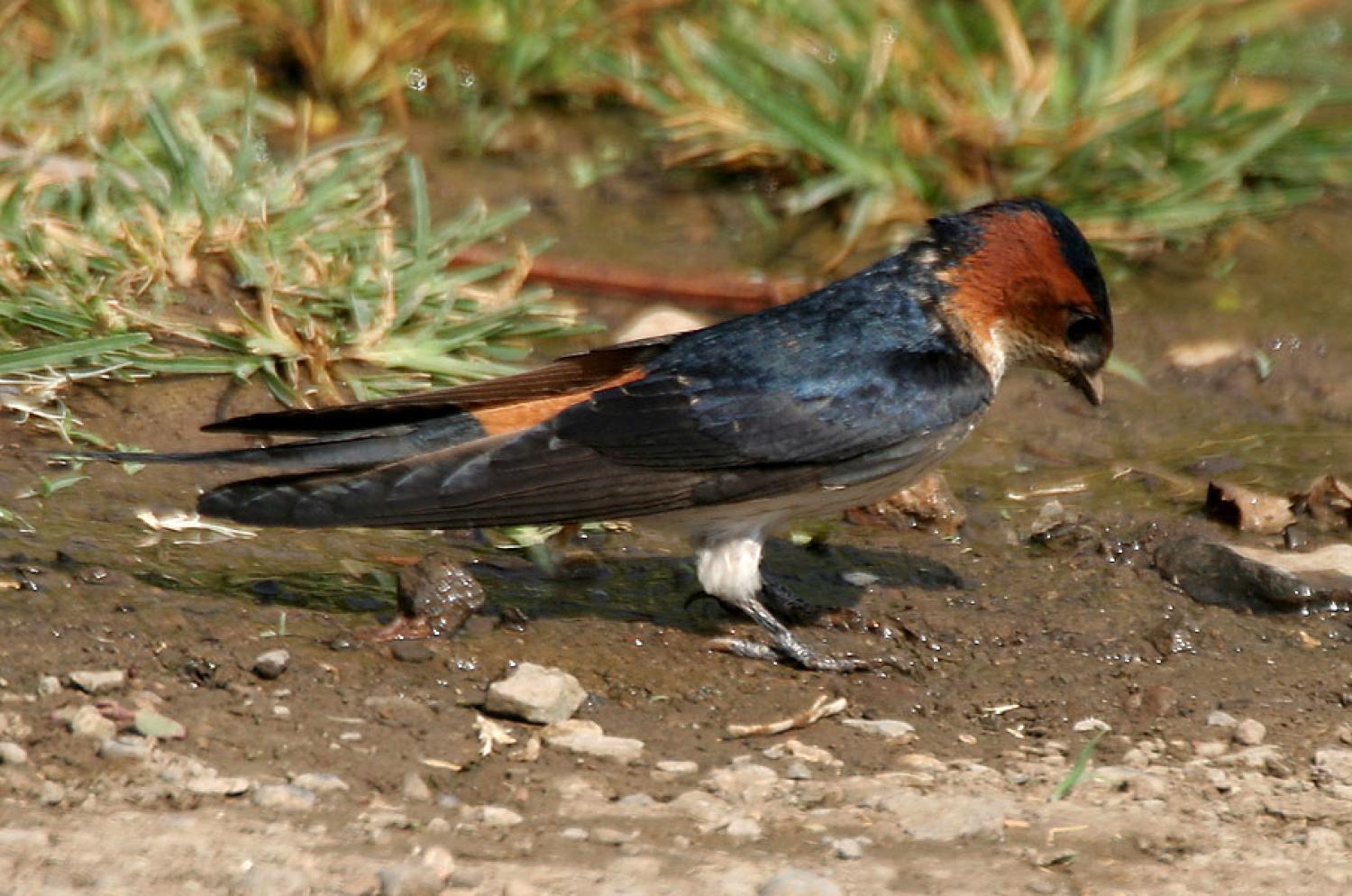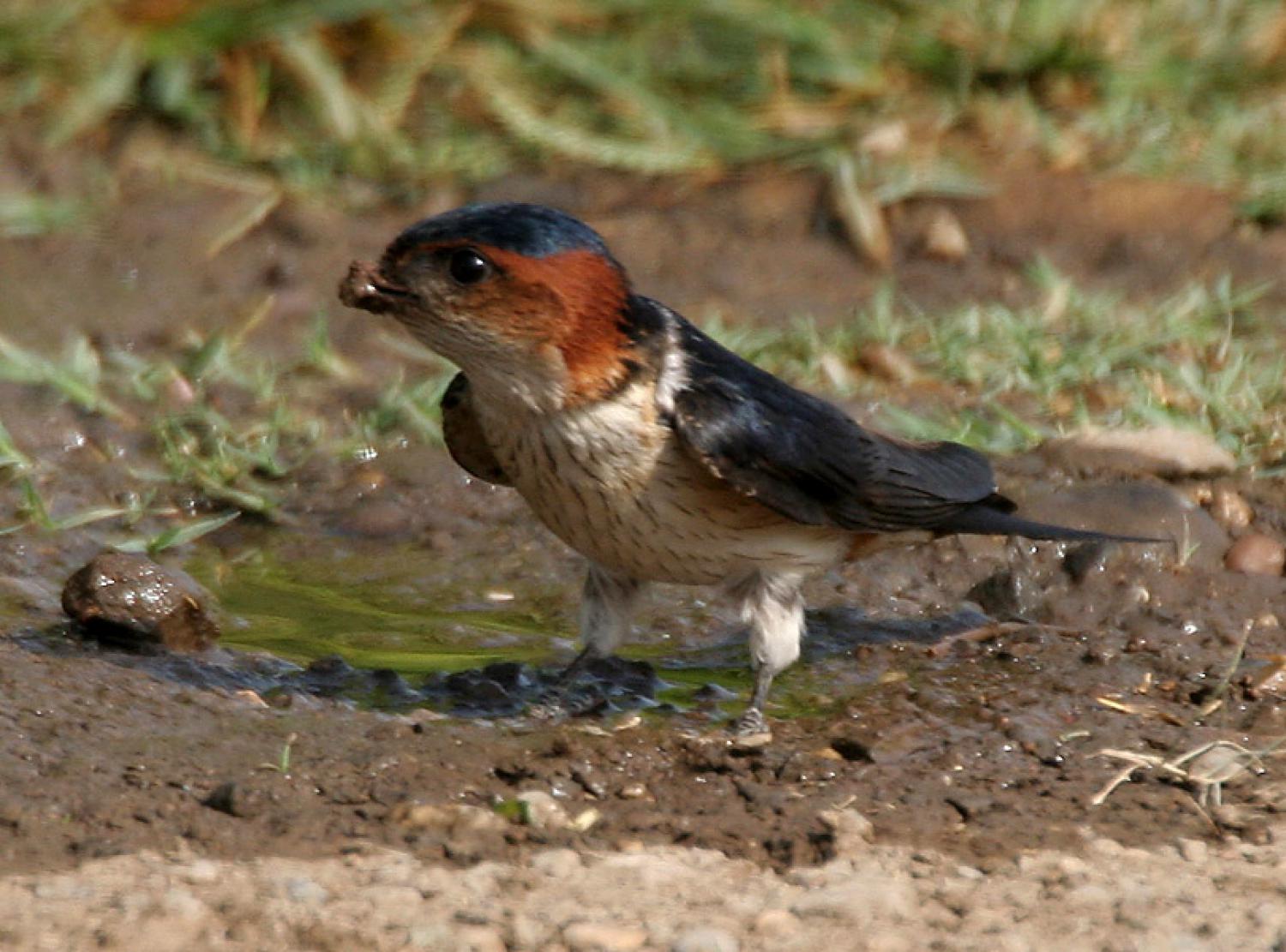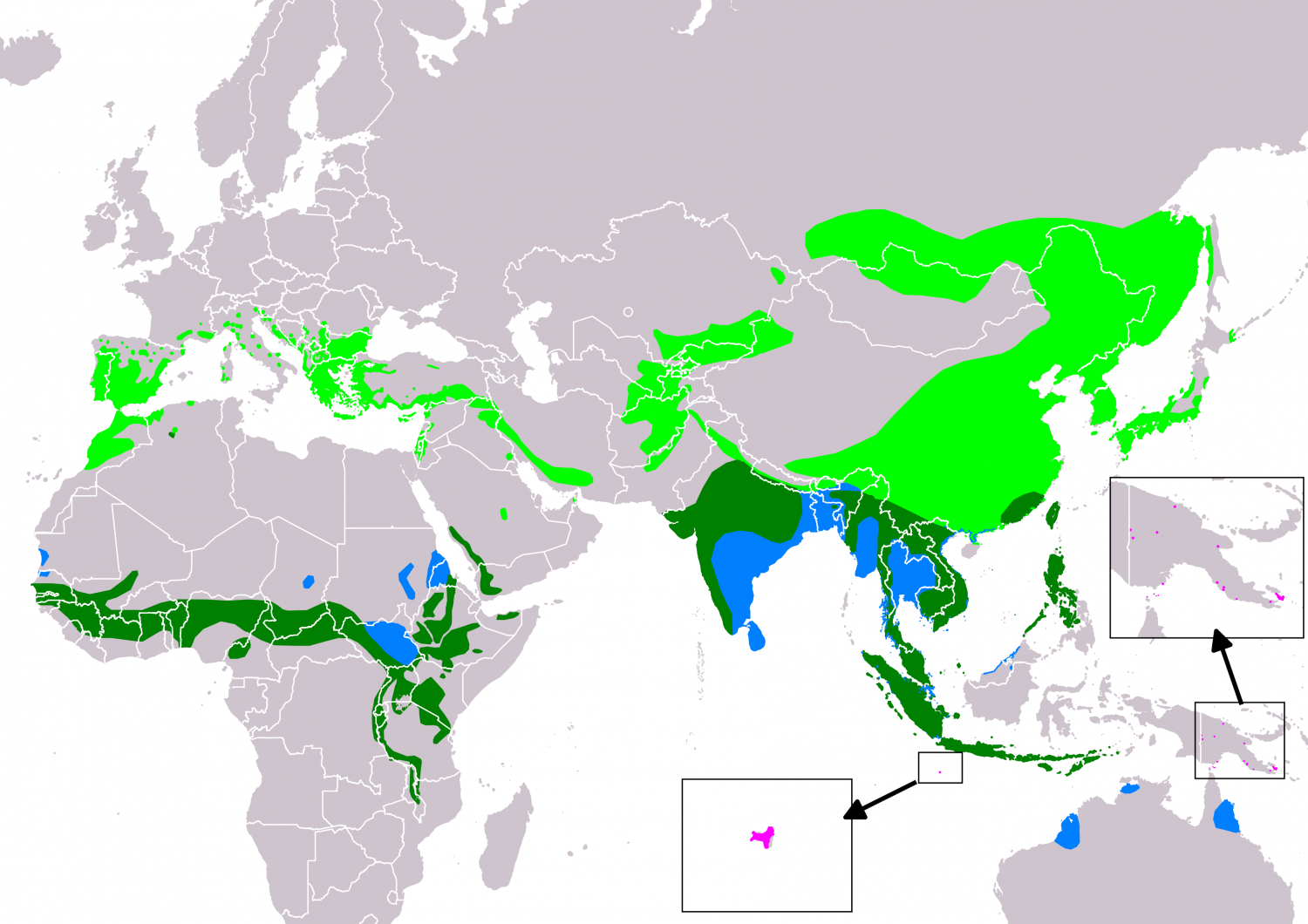Species of Thailand
Red-rumped swallow
Cecropis daurica
Erik Gustavovich Laxmann, 1769
In Thai: นกนางแอ่นตะโพกแดง
The red-rumped swallow (Cecropis daurica) is a small passerine bird in the swallow family. It breeds in open hilly country of temperate southern Europe and Asia from Portugal and Spain to Japan, India, Sri Lanka and tropical Africa. The Indian and African birds are resident, but European and other Asian birds are migratory. They winter in Africa or India and are vagrants to Christmas Island and northern Australia.
Red-rumped swallows are somewhat similar in habits and appearance to the other aerial insectivores, such as the related swallows and the unrelated swifts (order Apodiformes). They have blue upperparts and dusky underparts.
They resemble barn swallows, but are darker below and have pale or reddish rumps, face and neck collar. They lack a breast band, but have black undertails. They are fast fliers and they swoop on insects while airborne. They have broad but pointed wings.
Red-rumped swallows build quarter-sphere nests with a tunnel entrance lined with mud collected in their beaks, and lay 3 to 6 eggs. They normally nest under cliff overhangs in their mountain homes, but will readily adapt to buildings such as mosques and bridges.
They do not normally form large breeding colonies, but are gregarious outside the breeding season. Many hundreds can be seen at a time on the plains of India.
Taxonomy
The red-rumped swallow was formally described by Finnish-Swedish clergyman, explorer and natural scientist Erik Laxmann in 1769 as Hirundo daurica, using a specimen from Mount Schlangen near Zmeinogorsk Russia. It is now usually placed in the genus Cecropis created by German scientist Friedrich Boie in 1826, although it is arguable how distinct this genus is from Hirundo, and some authorities retain it in that genus. Boie's genus name Cecropis is from the Ancient Greek for an Athenian woman. The specific daurica is derived from Dauria, a mountainous region to the east of Lake Baikal in Russia. the alternative genus Hirundo is the Latin word for "swallow". Some authorities consider the West African swallow to be a subspecies of the red-rumped swallow.
This species is believed to form a superspecies complex with Hirundo striolata. The widely distributed population shows a lot of variation and several have been named as subspecies. Many of these are migratory and overlap in their wintering ranges and field identification of these forms is not reliable. The Sri Lankan breeding population hyperythra is a resident, and are now usually considered a distinct species, the Sri Lanka swallow. The underparts are deep chestnut and the nuchal collar is not well marked.
The populations in mainland India, erythropygia has the rump patch uniform dark chestnut without any dark shaft-streaks. The tail fork is shallow and the white patch on the inner web of the outer-tail feathers is indistinct. Populations of japonica breed in eastern Asia and winter in Thailand, Burma, India and northern Australia. They are heavily streaked on the underside and have faint streaks on the rump. The populations along the Himalayas nipalensis migrate to peninsular India in winter and breed from Kulu in the west to Bhutan and Arunachal Pradesh in the east. This population has the rump paler with dark shaft streaks. Subspecies rufula of Southern Europe, the Iberian Peninsula east to Baluchistan and Kashmir is resident and winters further south. The chestnut of rump fades to white towards the tail base. The nominate population breeds in Mongolia and Trans-Baikailia wintering in South and Southeast Asia. Subspecies gephyra of inner Mongolia is considered indistinguishable from the nominate subspecies. The African populations include kumboensis from the highlands of Sierra Leone and Cameroon; melanocrissus of the Ethiopian highlands and emini of Sudan, Uganda, Kenya and Zambia. Many of the variations are separable only on tail and wing lengths and these vary with overlap across populations.
Distribution and habitat
The red-rumped swallow breeds across southern Europe and Asia east to southern Siberia and Japan, These populations, along with Moroccan birds, are migratory, wintering in sub-Saharan Africa or south Asia. There are resident races in Africa in a broad belt from West Africa east to Ethiopia and then south to Tanzania, and most Indian and Sri Lanka breeders are also year-round residents. The African and Asian subspecies may undertake local seasonal movements. This species is a regular vagrant outside its breeding range.
Behaviour and ecology
These swallows are usually found over grassland where they hawk insects. They may sometimes take advantage of grass fires and grazing cattle that flush insects into the air.
Breeding
It is thought that the sequence "open-nest" to "closed nest" to "retort nest" represents the evolutionary development in the mud-building swallows, and individual species follow this order of construction. A retort builder like red-rumped swallow starts with an open cup, closes it, and then builds the entrance tunnel. It has been proposed that the development of closed nests reduced competition between males for copulations with the females. Since mating occurs inside the nest, the difficulty of access means other males are excluded. This reduction in competition permits the dense breeding colonies typical of the Delichon and Petrochelidon genera, but colonial breeding is not inevitable; most Cecropis species are solitary nesters.
Conservation status
The International Union for Conservation of Nature (IUCN) is the organisation responsible for assessing the conservation status of species. A species is assessed as subject to varying levels of threat if it has a small, fragmented or declining range, or if the total population is less than 10, 000 mature individuals, or numbers have dropped by more than 10% in ten years or with a continuing decline generations. Red-rumped swallow has a huge range and a population numbered in millions. It is not known to be seriously declining in range or numbers, so it is classed as Least Concern.
The red-rumped swallow is extending its range northward in Europe, colonising France and Romania in recent decades. The European population is estimated as 100, 000 to 430, 000 breeding pairs or 300, 000 to 1, 290, 000 individuals.
This article uses material from Wikipedia released under the Creative Commons Attribution-Share-Alike Licence 3.0. Eventual photos shown in this page may or may not be from Wikipedia, please see the license details for photos in photo by-lines.
Category / Seasonal Status
Wiki listed status (concerning Thai population): Winter visitor, local breeder
BCST Category: Recorded in an apparently wild state within the last 50 years
BCST Seasonal status: Non-breeding visitor
Scientific classification
- Kingdom
- Animalia
- Phylum
- Chordata
- Class
- Aves
- Order
- Passeriformes
- Family
- Hirundinidae
- Genus
- Cecropis
- Species
- Cecropis daurica
Common names
- Thai: นกนางแอ่นตะโพกแดง
Synonyms
- Hirundo daurica
Conservation status

Least Concern (IUCN3.1)
Photos
Please help us review the bird photos if wrong ones are used. We can be reached via our contact us page.
Range Map

- Amphawa District, Samut Songkhram
- Ao Phang-Nga National Park
- Ban Laem District, Phetchaburi
- Ban Lat District, Phetchaburi
- Bang Phra Non-Hunting Area
- Bang Pu Recreation Centre
- Bang Saphan Noi District, Prachuap Khiri Khan
- Bangkok Province
- Bueng Boraped Non-Hunting Area
- Chaloem Phrakiat Thai Prachan National Park
- Chiang Dao District, Chiang Mai
- Chiang Dao Wildlife Sanctuary
- Chiang Khan District, Loei
- Chiang Saen District, Chiang Rai
- Chum Ta Bong District, Nakhon Sawan
- Dan Chang District, Suphan Buri
- Doi Inthanon National Park
- Doi Lo District, Chiang Mai
- Doi Pha Hom Pok National Park
- Doi Phu Kha National Park
- Doi Suthep - Pui National Park
- Doi Tao District, Chiang Mai
- Fang District, Chiang Mai
- Hat Wanakon National Park
- Hua Hin District, Prachuap Khiri Khan
- Huai Chorakhe Mak Reservoir Non-Hunting Area
- Huai Kha Khaeng Wildlife Sanctuary
- Huai Nam Dang National Park
- Kabin Buri District, Prachinburi
- Kaeng Khoi District, Saraburi
- Kaeng Krachan District, Phetchaburi
- Kaeng Krachan National Park
- Kamphaeng Saen District, Nakhon Pathom
- Kantharawichai District, Maha Sarakham
- Khao Ang Rue Nai Wildlife Sanctuary
- Khao Dinsor (Chumphon Raptor Center)
- Khao Laem National Park
- Khao Laem Ya - Mu Ko Samet National Park
- Khao Luang National Park
- Khao Phra - Bang Khram Wildlife Sanctuary
- Khao Sam Roi Yot National Park
- Khao Sanam Prieng Wildlife Sanctuary
- Khao Soi Dao Wildlife Sanctuary
- Khao Sok National Park
- Khao Yai National Park
- Khao Yoi District, Phetchaburi
- Khemarat District, Ubon Ratchathani
- Khlong Luang District, Pathum Thani
- Khlong Saeng Wildlife Sanctuary
- Khuan Khanun District, Phatthalung
- Khura Buri District, Phang Nga
- Ko Chang National Park
- Ko Lanta National Park
- Kui Buri National Park
- Laem Pak Bia
- Mae Ai District, Chiang Mai
- Mae Ping National Park
- Mae Rim District, Chiang Mai
- Mae Sot District, Tak
- Mae Taeng District, Chiang Mai
- Mae Wong National Park
- Mu Ko Chumphon National Park
- Mueang Buriram District, Buriram
- Mueang Chiang Mai District, Chiang Mai
- Mueang Chonburi District, Chonburi
- Mueang Chumphon District, Chumphon
- Mueang Khon Kaen District, Khon Kaen
- Mueang Krabi District, Krabi
- Mueang Nan District, Nan
- Mueang Phetchaburi District, Phetchaburi
- Mueang Phuket District, Phuket
- Mueang Ratchaburi District, Ratchaburi
- Mueang Samut Sakhon District, Samut Sakhon
- Mueang Samut Songkhram District, Samut Songkhram
- Mueang Sukhothai District, Sukhothai
- Mueang Suphanburi District, Suphan Buri
- Mueang Tak District, Tak
- Mueang Uttaradit District, Uttaradit
- Nam Nao National Park
- Nong Bong Khai Non-Hunting Area
- Nong Saeng District, Udon Thani
- Nong Suea District, Pathum Thani
- Nong Ya Plong District, Phetchaburi
- Nong Yai Area Development Project Under Royal Init
- Op Khan National Park
- Pak Chong District, Nakhon Ratchasima
- Pak Phli District, Nakhon Nayok
- Pak Thale
- Pak Thong Chai District, Nakhon Ratchasima
- Pang Sila Thong District, Kamphaeng Phet
- Pha Daeng National Park
- Pha Hin Ngam National Park
- Pha Taem National Park
- Phaisali District, Nakhon Sawan
- Phi Phi Islands
- Phra Nakhon Si Ayutthaya District, Phra Nakhon Si Ayutthaya
- Phu Chi Fa Forest Park
- Phu Foi Lom National Park
- Phu Hin Rong Kla National Park
- Phu Khiao Wildlife Sanctuary
- Phu Kradueng National Park
- Phu Suan Sai National Park
- Phu Wiang National Park
- Phutthamonthon District, Nakhon Pathom
- Pran Buri District, Prachuap Khiri Khan
- Ramkhamhaeng National Park
- Sai Yok District, Kanchanaburi
- Sakaerat Environmental Research Station
- Samut Prakan Province
- San Sai District, Chiang Mai
- Sanam Bin Reservoir Non-Hunting Area
- Si Maha Phot District, Prachinburi
- Si Thep District, Phetchabun
- Similan Islands
- Sri Phang-nga National Park
- Surin Islands
- Taksin Maharat National Park
- Taphan Hin District, Phichit
- Tarutao National Marine Park
- Tha Takiap District, Chachoengsao
- Tha Yang District, Phetchaburi
- Thalang District, Phuket
- Thale Ban National Park
- Than Sadet - Koh Pha-Ngan National Park
- Thanyaburi District, Pathum Thani
- Thap Lan National Park
- Thong Pha Phum District, Kanchanaburi
- Thung Salaeng Luang National Park
- Thung Yai Naresuan Wildlife Sanctuary
- Umphang Wildlife Sanctuary
- Wang Chan District, Rayong
- Wang Noi District, Phra Nakhon Si Ayutthaya


